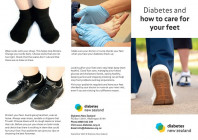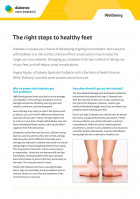Looking after your feet involves checking them every day, caring for them properly and wearing proper shoes. You should also avoid doing things that could damage your feet.
Foot checks
Check your feet every day for:
- blisters
- breaks in your skin
- pain
- changes in colour
- any signs of infection, such as redness, heat or swelling.
Remember to check between your toes too.
If you can't do this yourself, perhaps because your eyesight isn't good or you have problems reaching and seeing your feet, ask your partner or carer to help you. You could also use a magnifying mirror to see the bottom of your feet and check the backs of your heels.
If you discover any breaks in your skin, minor cuts or blisters:
- clean the area
- cover the area with a sterile dressing
- contact your podiatrist or healthcare provider immediately
- check the area daily
- see a healthcare provider if there's no sign of healing, or any sign of redness or infection, after 1 to 2 days. Go to your local after-hours clinic if it is after hours.
Foot care
Wash your feet every day.
- Use warm water and mild soap.
- You may not be able to feel hot or cold well, so test the water temperature first with your elbow or ask someone to do it for you.
- Rinse your feet thoroughly.
- Don't soak your feet, as this may damage your skin.
- Dry your feet carefully, especially between your toes.
If your skin is dry, apply a moisturising cream every day. Avoid the areas between your toes. Wear socks and change them every day. Choose socks without thick seams or tight elastic. White socks are good as you can see any blood if you damage your foot and you haven't felt it.
Always remove hot water bottles or heating pads from your bed before getting in, as these can burn your feet.
Shoes
Always wear shoes, even indoors. You could use slippers indoors or keep special ‘inside’ shoes.
Make sure your shoes fit well, are comfortable and protect your whole foot, eg, a cushioned sports shoe. If you have neuropathy (nerve damage) or numbness in your feet, make sure your shoes aren't too tight as you can't feel if they fit properly.
Wearing jandals puts you at risk of getting cuts and scrapes on your feet. A podiatrist can advise you about shoes, including buying new shoes or getting prescription shoes.
Before you put on your shoes, check the bottom to make sure nothing sharp has pierced the outer sole. Run your hand inside each shoe to check that no small objects such as small stones have fallen in.
If your podiatrist or orthotist (the person who makes the shoes) has supplied you with prescription shoes:
- follow the instructions they give you
- only wear these shoes
- only remove insoles if your orthotist or podiatrist advises you to
- contact your podiatrist or orthotist if the shoes are damaged or not fitting well.
Things to avoid
- Don’t walk barefoot, even indoors, as you could stub your toes or stand on something sharp.
- Don't cut into the corners of your toenails, as this can lead to ingrown nails.
- Don’t burst blisters or try to remove hard skin or corns yourself. A podiatrist can provide advice and treatment.
- Don’t use over-the-counter corn remedies, as they can damage your skin and cause ulcers.
- Don’t sit with your feet in front of a fire or heater to warm them up. If your feet can’t feel heat well they can easily get burnt without you realising.









